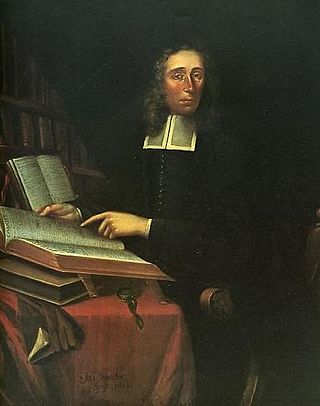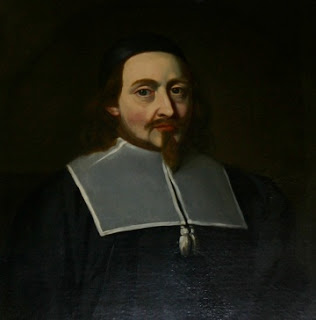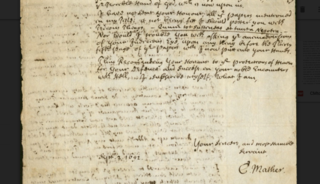
Cotton Mather was a New England Puritan clergyman, theologian, and writer. Beginning his Harvard College undergraduate education at age twelve, he is the youngest person ever to be admitted there. In 1685, he joined his father, Increase Mather, who eventually became the sixth President of Harvard, as minister of the Congregationalist Old North Meeting House of Boston. He preached there for the rest of his life. Cotton Mather is remembered as one of the most influential Puritan ministers of his day, and was overall, a highly influential figure in early America.

The Salem witch trials were a series of hearings and prosecutions of people accused of witchcraft in colonial Massachusetts between February 1692 and May 1693. More than 200 people were accused. Thirty people were found guilty, 19 of whom were executed by hanging. One other man, Giles Corey, died under torture after refusing to enter a plea, and at least five people died in jail.

Increase Mather was a New England Puritan clergyman in the Massachusetts Bay Colony and president of Harvard College for twenty years (1681–1701). He was influential in the administration of the colony during a time that coincided with the notorious Salem witch trials.
John Hathorne was a merchant and magistrate of the Massachusetts Bay Colony and Salem, Massachusetts. He is best known for his early and vocal role as one of the leading judges in the Salem witch trials.
John Proctor, Jr. was a landowner in the Massachusetts Bay Colony. He was the son of John Proctor Sr. (1594–1672) and Martha Harper (1607–1667). John and his 3rd wife were tried on August 5, 1692. He was hanged on August 19, 1692 in Salem Village, Massachusetts Bay Colony during the Salem Witch Trials after being falsely accused and convicted of witchcraft.

John Endecott, regarded as one of the Fathers of New England, was the longest-serving governor of the Massachusetts Bay Colony, which became the Commonwealth of Massachusetts. He served a total of 16 years, including most of the last 15 years of his life. When not serving as governor, he was involved in other elected and appointed positions from 1628 to 1665 except for the single year of 1634.
Elizabeth Proctor was convicted of witchcraft in the Salem Witch Trials of 1692. She was the wife of John Proctor, who was convicted and executed.

Bridget Bishop was the first person executed for witchcraft during the Salem witch trials in 1692. Nineteen were hanged, and one, Giles Corey, was pressed to death. Altogether, about 200 people were tried.

George Burroughs was a non-ordained Puritan preacher who was the only minister executed for witchcraft during the course of the Salem witch trials. He is remembered especially for reciting the Lord's Prayer during his execution, something it was believed a witch could never do.
Ann Austin was one of the first Quaker travelling preachers. She and Mary Fisher became the first Quakers to visit the English North American colonies.

Goody Ann Glover was the last person to be hanged in Boston as a witch, although the Salem witch trials in nearby Salem, Massachusetts, occurred mainly in 1692.

Susannah Martin was one of fourteen women executed for the suspicion of practicing witchcraft during the Salem witch trials of colonial Massachusetts.

Cultural depictions of the Salem witch trials abound in art, literature and popular media in the United States, from the early 19th century to the present day. The literary and dramatic depictions are discussed in Marion Gibson's Witchcraft Myths in American Culture and see also Bernard Rosenthal's Salem Story: Reading the Witch Trials of 1692
Thomas Brattle was an American merchant who served as treasurer of Harvard College and member of the Royal Society. He is known for his involvement in the Salem Witch Trials and the formation of the Brattle Street Church.
Sarah Cloyce was among the many accused during Salem Witch Trials including two of her older sisters, Rebecca Nurse and Mary Eastey, who were both executed. Cloyce was about 50-years-old at the time and was held without bail in cramped prisons for many months before her release.

Ann Hibbins was a woman executed for witchcraft in Boston, Massachusetts, on June 19, 1656. Her death by hanging was the third for witchcraft in Boston and predated the Salem witch trials of 1692. Hibbins was later fictionalized in Nathaniel Hawthorne's famous novel The Scarlet Letter. A wealthy widow, Hibbins was the sister-in-law by marriage to Massachusetts governor Richard Bellingham. Her sentence was handed down by Governor John Endicott.
Margaret Jones was the first person to be executed for witchcraft in Massachusetts Bay Colony, and the second in New England during a witch-hunt that lasted from 1647 to 1693. Hundreds of people throughout New England were accused of practicing witchcraft during that period, including over two hundred in 1692 during the Salem Witch Trials. Prior to the Salem Witch Trials of 1692, over a forty-one year period (1647–1688), nine women, including Margaret Jones, were hanged as witches.

Robert Pike (1616—1706) was an opponent of the Salem witchcraft prosecutions of 1692. He was also involved in two other notable, public controversies prior to 1692. The first was his open criticism of the persecution of the Quakers, for which he was arraigned by the Massachusetts General Court in 1653. Years later, he became embroiled in a long feud with the pastor of Salisbury, the Reverend John Wheelwright, who excommunicated him in 1675 and was later obliged to reinstate him.

In a letter dated September 2, 1692, Cotton Mather wrote to judge William Stoughton. Among the notable things about this letter is the provenance: it seems to be the last important correspondence from Mather to surface in modern times, with the holograph manuscript not arriving in the archives for scholars to view, and authenticate, until sometime between 1978 and 1985.












